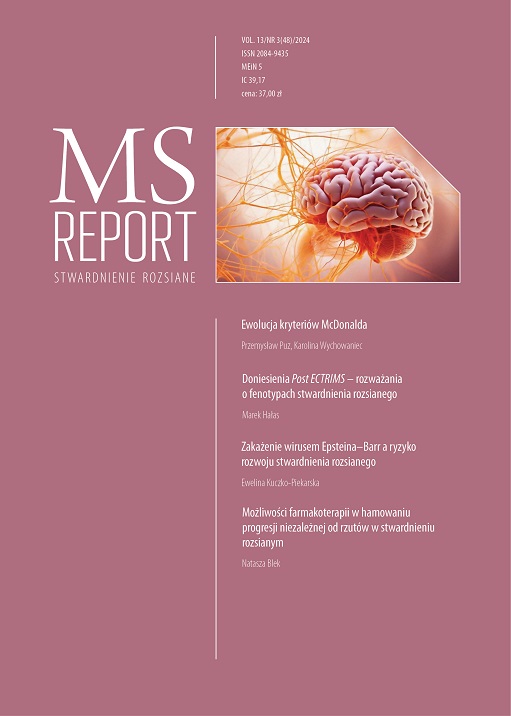Evolution of McDonald’s criteria Review article
Main Article Content
Abstract
The McDonald criteria used to diagnose multiple sclerosis have evolved over the past quarter century. They were first promulgated in 2001, and every few years they are revised, allowing to increase the sensitivity and specificity of the criteria and to accelerate the diagnosis of the disease, which significantly affects the earlier inclusion of appropriate disease-modifying therapies. The latest modification was presented at this year’s ECTRIMS congress in September 2024. The basic tenets of the changes to the McDonald criteria include: recognition of a history of relapses as equivalent to clinically isolated syndrome, recognition of radiologically isolated syndrome as a specific situation of multiple sclerosis, inclusion of the optic nerve as the fifth topographic location of lesions typical of multiple sclerosis, and abandonment of the criterion of spread over time as a prerequisite for the diagnosis of multiple sclerosis. In terms of both laboratory and neuroimaging diagnosis, new diagnostic tools have been proposed: central vein sign and paramagnetic rim enhancement lesions on magnetic resonance imaging and the presence of kappa free light chains in cerebrospinal fluid. The use of the newly proposed criteria for diagnosing MS allows for easier diagnosis of the disease in selected patients and diagnosis of the disease for patients who could not be diagnosed with multiple sclerosis based on previous criteria.
Article Details
Copyright © by Medical Education. All rights reserved.
References
2. Kuhlmann T, Moccia M, Coetzee T et al. International Advisory Committee on Clinical Trials in Multiple Sclerosis. Multiple sclerosis progression: time for a new mechanism-driven framework. Lancet Neurol. 2023; 22(1): 78-88. http://doi.org/10.1016/S1474-4422(22)00289-7.
3. Thompson AJ, Banwell BL, Barkhof F et al. Diagnosis of multiple sclerosis: 2017 revisions of the McDonald criteria. Lancet Neurol. 2018; 17(2): 162-73. http://doi.org/10.1016/S1474.
4. Miller DH, Chard DT, Ciccarelli O. Clinically isolated syndromes. Lancet Neurol. 2012; 11: 157-69. http://doi.org/10.1016/S1474-4422(11)70274-5.
5. Sorensen PS, Sellebjerg F, Hartung HP et al. The apparently milder course of multiple sclerosis: changes in the diagnostic criteria, therapy and natural history. Brain. 2020; 143(9): 2637-52. http://doi.org/10.1093/brain/awaa145.
6. Traboulsee AL, Li DK. The role of MRI in the diagnosis of multiple sclerosis. Adv Neurol. 2006; 98: 125-46.
7. Filippi M, Rocca MA, Calabrese M et al. Intracortical lesions: relevance for new MRI diagnostic criteria for multiple sclerosis. Neurology. 2010; 75(22): 1988-94. http://doi.org/10.1212/WNL.0b013e3181ff96f6.
8. McDonald WI, Compston A, Edan G et al. Recommended diagnostic criteria for multiple sclerosis: guidelines from the International Panel on the diagnosis of multiple sclerosis. Ann Neurol. 2001; 50(1): 121-7. http://doi.org/10.1002/ana.1032.
9. Poser CM, Paty DW, Scheinberg L et al. New diagnostic criteria for multiple sclerosis: guidelines for research protocols. Ann Neurol. 1983; 13(3): 227-31. http://doi.org/10.1002/ana.410130302.
10. Dalton CM, Brex PA, Miszkiel KA et al. Application of the new McDonald criteria to patients with clinically isolated syndromes suggestive of multiple sclerosis. Ann Neurol. 2002; 52(1): 47-53. http://doi.org/10.1002/ana.10240.
11. Milo R, Miller A. Revised diagnostic criteria of multiple sclerosis. Autoimmun Rev. 2014; 13(4-5): 518-24. http://doi.org/10.1016/j.autrev.2014.01.012.
12. Polman CH, Reingold SC, Edan G et al. Diagnostic criteria for multiple sclerosis: 2005 revisions to the „McDonald Criteria”. Ann Neurol. 2005; 58(6): 840-6. http://doi.org/10.1002/ana.20703.
13. Swanton JK, Fernando K, Dalton CM et al. Modification of MRI criteria for multiple sclerosis in patients with clinically isolated syndromes. J Neurol Neurosurg Psychiatry. 2006; 77(7): 830-3. http://doi.org/10.1136/jnnp.2005.073247.
14. Polman CH, Reingold SC, Banwell B et al. Diagnostic criteria for multiple sclerosis: 2010 revisions to the McDonald criteria. Ann Neurol. 2011; 69(2): 292-302. http://doi.org/10.1002/ana.22366.
15. Deisenhammer F, Zetterberg H, Fitzner B et al. The Cerebrospinal Fluid in Multiple Sclerosis. Front Immunol. 2019; 10: 726. http://doi.org/10.3389/fimmu.2019.00726.
16. Kennedy PGE, George W, Yu X. The elusive nature of the oligoclonal bands in multiple sclerosis. J Neurol. 2024; 271(1): 116-24. http://doi.org/10.1007/s00415-023-12081-7.
17. Schwenkenbecher P, Wurster U, Konen FF et al. Impact of the McDonald Criteria 2017 on Early Diagnosis of Relapsing-Remitting Multiple Sclerosis. Front Neurol. 2019; 10: 188. http://doi.org/10.3389/fneur.2019.00188.
18. Montalban X. Revised McDonald criteria 2023. ECTRIMS 2024, Copenhagen 18-20 Sep 2024.
19. Wattjes MP, Ciccarelli O, Reich DS et al. Magnetic Resonance Imaging in Multiple Sclerosis study group; Consortium of Multiple Sclerosis Centres; North American Imaging in Multiple Sclerosis Cooperative MRI guidelines working group. 2021 MAGNIMS-CMSC-NAIMS consensus recommendations on the use of MRI in patients with multiple sclerosis. Lancet Neurol. 2021; 20(8): 653-70. http://doi.org/10.1016/S1474-4422(21)00095-8.
20. Clarke MA, Samaraweera AP, Falah Y et al. Single Test to ARrive at Multiple Sclerosis (STAR-MS) diagnosis: A prospective pilot study assessing the accuracy of the central vein sign in predicting multiple sclerosis in cases of diagnostic uncertainty. Mult Scler. 2020; 26(4): 433-41. http://doi.org/10.1177/1352458519882282.
21. Ontaneda D, Sati P, Raza P et al. North American Imaging in MS Cooperative. Central vein sign: A diagnostic biomarker in multiple sclerosis (CAVS-MS) study protocol for a prospective multicenter trial. Neuroimage Clin. 2021; 32: 102834. http://doi.org/10.1016/j.nicl.2021.102834.
22. Meaton I, Altokhis A, Allen CM et al. Paramagnetic rims are a promising diagnostic imaging biomarker in multiple sclerosis. Mult Scler. 2022; 28(14): 2212-20. http://doi.org/10.1177/13524585221118677.
23. Hegen H, Walde J, Berek K et al. Cerebrospinal fluid kappa free light chains for the diagnosis of multiple sclerosis: A systematic review and meta-analysis. Mult Scler. 2023; 29(2): 169-81. http://doi.org/10.1177/13524585221134213.
24. Vidal-Jordana A, Sastre-Garriga J, Tintoré M et al. Optic nerve topography in multiple sclerosis diagnostic criteria: Existing knowledge and future directions. Mult Scler. 2024; 30(2): 139-49. http://doi.org/10.1177/13524585231225848.
25. Okuda DT, Mowry EM, Beheshtian A et al. Incidental MRI anomalies suggestive of multiple sclerosis: the radiologically isolated syndrome. Neurology. 2009; 72(9)800-5. http://doi.org/10.1212/01.wnl.0000335764.14513.1a.
26. Landes-Chateau C, Levraut M, Okuda DT et al; on behalf RISConsortium. The diagnostic value of the central vein sign in radiologically isolated syndrome. Ann Clin Transl Neurol. 2024; 11(3): 662-72. http://doi.org/10.1002/acn3.51986.
27. Lebrun-Frénay C, Okuda DT, Siva A et al. The radiologically isolated syndrome: revised diagnostic criteria. Brain. 2023; 146(8): 3431-43. http://doi.org/10.1093/brain/awad073.

